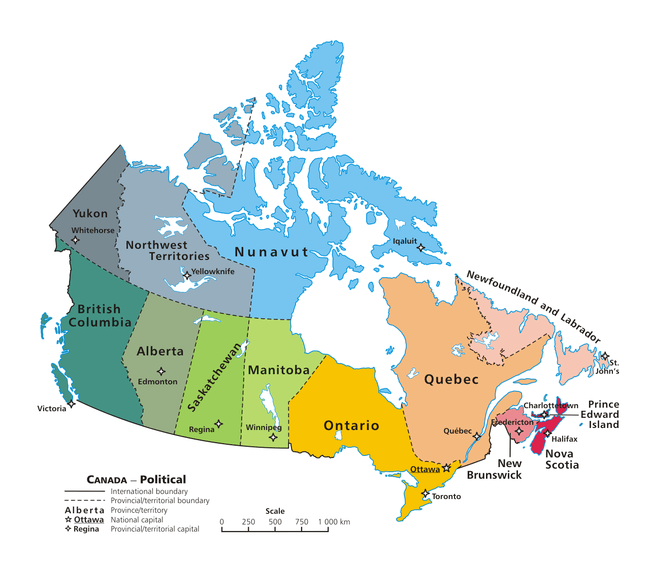List of Canadian provinces and territories by area
As a country, Canada has ten provinces and three territories. These subdivisions vary widely in both land and water area. The largest subdivision by land area is the territory of Nunavut. The largest subdivision by water area is the province of Quebec. The smallest subdivision of both land and water area is the province of Prince Edward Island.[1]

Canada is the second-largest country in the world; it has the fourth largest dry land area, and the largest freshwater area.[2]
Listings
Total area
The total area of a province or territory is the sum of its land area and its freshwater area.
Areas are rounded to the nearest square kilometre or square mile. Percentages are given to the nearest tenth of a percent.
| Rank | Name | Total area (km2)[1] | Total area (mi2)[1] | Percentage of national total area[1] |
|---|---|---|---|---|
| 1 | |
2,093,190 | 808,185 | 21.0% |
| 2 | |
1,542,056 | 595,391 | 15.4% |
| 3 | |
1,346,106 | 519,734 | 13.5% |
| 4 | |
1,076,395 | 415,598 | 10.8% |
| 5 | |
944,735 | 364,764 | 9.5% |
| 6 | |
661,848 | 255,541 | 6.6% |
| 7 | |
651,036 | 251,366 | 6.5% |
| 8 | |
647,797 | 250,116 | 6.5% |
| 9 | |
482,443 | 186,272 | 4.8% |
| 10 | |
405,212 | 156,453 | 4.1% |
| 11 | |
72,908 | 28,150 | 0.7% |
| 12 | |
55,284 | 21,345 | 0.6% |
| 13 | |
5,660 | 2,185 | 0.1% |
| Total | |
9,984,670 | 3,855,103 | 100.0% |
Land area
Land areas consist of dry land, excluding areas of freshwater.
Areas are rounded to the nearest whole unit. Percentages are given to the nearest tenth of a percent.
| Rank | Name and flag | Land area (km2)[1] | Land area (mi2)[1] | Percentage of national land area |
|---|---|---|---|---|
| 1 | |
1,936,113 | 747,537 | 21.3% |
| 2 | |
1,365,128 | 527,079 | 15.0% |
| 3 | |
1,183,085 | 456,792 | 13.0% |
| 4 | |
925,186 | 357,216 | 10.4% |
| 5 | |
917,741 | 354,342 | 10.1% |
| 6 | |
642,317 | 248,000 | 7.1% |
| 7 | |
591,670 | 228,445 | 6.5% |
| 8 | |
553,556 | 213,729 | 6.1% |
| 9 | |
474,391 | 183,163 | 5.2% |
| 10 | |
373,872 | 144,353 | 4.1% |
| 11 | |
71,450 | 27,587 | 0.8% |
| 12 | |
53,338 | 20,594 | 0.6% |
| 13 | |
5,660 | 2,185 | 0.1% |
| Total | |
9,093,507 | 3,511,023 | 100.0% |
Freshwater area
Freshwater area consists of lakes, rivers, and reservoirs. It excludes territorial waters claimed by Canada in the Atlantic, Pacific, and Arctic Oceans. Canada has no significant inland areas of salt water.
Areas are given to the nearest whole unit. Percentages are given to the nearest tenth of a percent.
| Rank | Name and flag | Water area (km2)[1] | Water area (mi2)[1] | Water area as percentage of total area |
Percentage of national freshwater area |
|---|---|---|---|---|---|
| 1 | |
176,928 | 68,312 | 11.5% | 19.9% |
| 2 | |
163,021 | 62,943 | 12.1% | 18.3% |
| 3 | |
158,654 | 61,257 | 14.7% | 17.8% |
| 4 | |
157,077 | 60,648 | 7.5% | 17.6% |
| 5 | |
94,241 | 36,387 | 14.5% | 10.6% |
| 6 | |
59,366 | 22,921 | 9.1% | 6.7% |
| 7 | |
31,340 | 12,100 | 7.7% | 3.5% |
| 8 | |
19,549 | 7,548 | 2.1% | 2.2% |
| 9 | |
19,531 | 7,541 | 3.0% | 2.2% |
| 10 | |
8,052 | 3,109 | 1.7% | 0.9% |
| 11 | |
1,946 | 751 | 3.5% | 0.2% |
| 12 | |
1,458 | 563 | 2.0% | 0.2% |
| 13 | |
0 | 0 | 0.0% | 0.0% |
| Total | |
891,163 | 344,080 | 8.9% | 100.0% |
See also
References
- ↑ 1.0 1.1 1.2 1.3 1.4 1.5 1.6 1.7 "Land and freshwater area, by province and territory". Statistics Canada. 2005-02-01. Retrieved 2009-11-30.
- ↑ Field Listing:: Area. CIA World Factbook. Central Intelligence Agency. Retrieved 2009-11-30.
Further reading
- Moore, Christopher; Slavin, Bill. Janet Lunn (2002), The Big Book of Canada: Exploring the Provinces and Territories, Tundra Books, ISBN 0-88776-457-6
| ||||||||||||||||||||||
| ||||||||||||||||||
